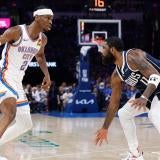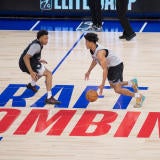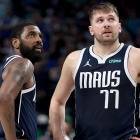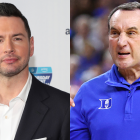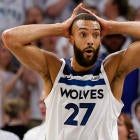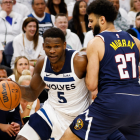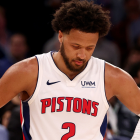Each summer, NBA Hall of Famer Hakeem Olajuwon hosts a bevy of NBA big men to try and impart the wisdom of how to be great down low. For years, the NBA has suffered through a drought of great centers. The league's recent trend towards small ball creates a chicken-and-the-egg situation; you can argue big men development has been de-emphasized with a move towards smaller, faster, more nimble lineups, or you can argue those lineups are the result of not having a better option with the talent available.
Kevin Garnett's a center now. Chris Bosh plays one most of the time, too. Al Horford has done great things at the center position and is unquestionably a center, but he's not in any way built in the traditional model.
So Olajuwon hosts players and tries to make them better, even this summer after signing a deal to be an assistant with Houston and mentor Dwight Howard. Videos leak of player replicating the Dream Shake, working on footwork, trying to become low post options. And each year, I find myself asking why it seems Olajuwon doesn't offer more lessons on defense.
You're talking about a player that averaged three blocks a game, four in his peak seasons. From 1987 to 1995, Olajuwon placed first in defensive win shares (via Basketball Reference) four times, second twice. He ranked 1st in defensive rating (points per 100 possessions allowed while he was on the floor) five times, second twice. He was an all-world defender.
Maybe Olajuwon does spend time with the young bucks teaching them the ins and outs of post defense, and we just don't hear about it, because it's not sexy. But you would think that at some point, that would become a conversation. There does seem to be a resistance, though, based on the idea that with the rule changes enacted over the past 15 years, Olajuwon's brand of defense is no longer applicable for most centers, who are much more focused on rotation defense now.
But over the past few years, teams have progressively taken more and more leaps with young, athletic big men with crazy length. JaVale McGee, DeAndre Jordan, and Larry Sanders have all gotten massive contracts that caused critics to ask what they had accomplished to deserve that kind of cash. But speaking to GMs, you find that the idea is based not around who these players are, but who they will become. Most GMs believe a big man reaches his peak effectiveness at age 27 or 28. This is traditionally considered the "Tyson Chandler model," as the Knicks' defensive stalwart didn't start to come into his own until he landed in New Orleans at age 24, and didn't become elite until Dallas at age 28.
There is another player to use as a model for the "let them grow" angle, though.
Dikembe Mutombo Mpolondo Mukamba Jean-Jacques Wamutombo entered the league at age 25. He wasn't even supposed to play basketball. He enrolled at Georgetown on a USAID scholarship to become a doctor before John Thompson recognized his potential. In time, Mutombo would become one of the league's best global ambassadors. But during his time in the league, he was maybe the most feared shot blocker on the planet.
He consistently ranked top 10 in block percentage (percentage of available shots blocked) and in 1996, blocked a ridiculous 4.5 shots per game. Now, blocks are a terrible indicator of actual defensive prowess. They can lead to secondary possessions where the opponent scores, and chasing those blocks leads to open baskets for a defender's man on the ball rotation. But any NBA player will tell you that having a monster like that down low, just the threat of the block is enough to deter a player from driving, which makes everything easier.
Mutombo presents maybe a better model for big men to learn from than Olajuwon. Olajuwon's individual basketball intelligence and natural skill made him an all-time legend. Mutombo was never an elite-level player but he was a four-time defensive player of the year, trying to develop unnatural skills like post moves and offensive ability which is dependent on coordination and grace. Mutombo was a consistent All-Star in his prime, but his unique brand of attacking at the rim could be more easily integrated to various NBA systems. Yes, the development of stretch fours and fives complicates the matter, but schematic defenses can adjust for that better than they can to trying to force action to the rim to prevent scoring opportunities when the defender is pulled back.
Mutombo is often forgotten despite only having retired four years ago. (He played until he was 42!) But trying to become Mutombo shouldn't be lowering the bar for any NBA player. His singular greatness should be appreciated, and if more players studied the Finger Wag Man, it might present an easier path to fulfilling that potential that remains wanting at the center position in today's NBA.









